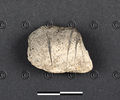NO-5 potsherd
| Object | |
|---|---|
| Classification: | vessel |
| Material: | pottery |
| Size: | length 2.8 cm, height 2.2 cm |
| Condition: | fragmentary |
| Archaeological culture: | Late Iron Age |
|
| |
| Site: | Mechel / Meclo (fraction of: Cles, Trento, Trentino-Alto Adige, Italy) |
| Field name: | Valemporga |
| Coordinates (approx.): | 46° 20' 58.45" N, 11° 1' 12.94" E |
| Find date: | 1885–86 |
| Find circumstances: | excavation |
| Current location: | Castello del Buonconsiglio (repository) |
| Inventory Nr.: | 6395 |
|
| |
| Inscription: | NO-5 ((?)]?a[) |
|
| |
| Sources: | Pauli 1888: 144–145 Campi 1889: pl. II.3 |
Images
|
Object NO-5 potsherd with inscription NO-5.
|
Commentary
Ceramic fragment.
According to the scholary literature the object was indicated as bone (see discussion below). However, this indication is erroneous. The autopsy by the Thesaurus Inscriptionum Raeticarum and in consequence the analysis under a microscope by the museum staff have demonstrated that the present object is a ceramic fragment. Under a microscope the temper particles ("inclusioni di impasto") are clearly visible.
Due to the fragmentary state the vessel type is not determinable anymore. In profile slightly curved.
Outside, i.e. on the convex surface, a fragmentary inscription; however, only two characters are preserved.
The present ceramic fragment presents one of the findings from Mechel / Meclo. In the late 19th century Luigi Campi directed excavations in this area. The potsherd was discovered during the excavations executed between 1885 and 1886. In the same years also two other inscribed objects were found: a miniature bronze plaque in the shape of a shield and an antler handle. These inscribed objects were first published by Pauli whereas Pauli's study is part of Campi's excavation report (cp. Campi 1888 and Campi 1889; in Campi 1889 on plate II were also indicated drawings of the inscribed objects).
An exact age determination related to the object is obviously not possible. However, concerning the archaeological context as well as the characters on the potsherd a dating to the Late Iron Age is comprehensible.
As mentioned above the material indication given so far by the scholars is erroneous. In the introduction to Pauli's study Campi mentions only bone ("osso") or bone fragments ("frammenti di osso") (cp. Campi 1888: 137–139). In the sequel of the excavation report from 1889 he discusses the pottery, glass and bone findings in one chapter without giving detailed information about the single objects in particular (cp. Campi 1889: 250–253). Related to the present fragment and the material Pauli states: "un materiale, che per la sua porosità (...) si qualifica per osseo, quantunque la massa che è di un certo peso si potrebbe ritenere di natura minerale. Forse qui abbiamo un frammento osseo petrificato (...)" (cp. Pauli 1888: 144–145; accentuations in bold by S.K.). Therefore the erroneous material indication traces back to the incorrect statement given by Campi and Pauli, i.e. the excavator of the object and the first editor of the inscription. In consequence all scholars followed this indication: Untersteiner describes "una placca di bronzo, un frammento d'osso, ed altro frammento d'osso" discovered in Mechel / Meclo (cp. Untersteiner 1896: 28). Whatmough indicates the object with No. 212 and states "another fragment of bone" whereas he follows obviously only Pauli's indication (cp. PID: 25 [No. 212]). In NRIE the object resp. the inscription are listed with No. 110: "frammento d'osso" (cp. NRIE: 44). In 1957 Mayr published three bone fragments resp. objects preserved in the Castello del Buonconsiglio. With No. 2 he describes the present fragment. Although he states that the original object type is not determinable anymore due to the extant small size, he argues a "Knochenstück" (bone piece) (cp. Mayr 1957: 231). Schumacher indicates with the siglum NO-5 a "Knochenstück" (bone piece) (cp. Schumacher 2004: 151). The object is listed within the group of "Hirschgeweihvotive" by Nothdurfter (cp. Nothdurfter 2002: 1148, Liste 3: Hirschgeweihvotive, 2.3). The object was not part of the IR by Mancini, however in the LIR Mancini incorporates the inscribed fragment and quotes the description given by Pauli 1888. The index card No. 6395 of the museum related to the object indicates also "frammento d'osso".
Concerning the findspot and the find year the fragment must be connected with the other objects discovered in Mechel / Meclo and listed in the Thesaurus Inscriptionum Raeticarum: NO-3 plaque and NO-4 handle. Concerning the material discussion and the previous antler indication the object must be associated with NO-4 handle and NO-7 antler. The latter three objects come from Mechel / Meclo, are preserved in the Castello del Buonconsiglio and were discussed together in the scholary literature (cp. Mayr 1957b: 231; Nothdurfter 2002: 1148).
Autopsied by the Thesaurus Inscriptionum Raeticarum in October 2014.
Bibliography
| Campi 1888 | Luigi Campi, "Scavi e scoperte fatti negli anni 1885–1886 nello stabile a Valemporga di Meclo nell’Anaunia. Parte I", Archivio Trentino VII (1888), 129–184. |
|---|---|
| Campi 1889 | Luigi Campi, "Scavi e scoperte fatti negli anni 1885-1886 nello stabile a Valemporga di Meclo nell’Anaunia. Parte II", Archivio Trentino VIII (1889), 209–261. |
| IR | Alberto Mancini, "Iscrizioni retiche", Studi Etruschi 43 (1975), 249–306. |
| LIR | Alberto Mancini, Le Iscrizioni Retiche [= Quaderni del dipartimento di linguistica, Università degli studi di Firenze Studi 8–9], Padova: Unipress 2009–10. (2 volumes) |
| Mayr 1957 | Karl M. Mayr, "Hirschhornvotive mit rätischen Inschriften aus Meclo (Mechel) am Nonsberg", Der Schlern 31 (1957), 230–231. |
| Mayr 1957b | Karl M. Mayr, "Reitia-Inschrift vom Piperbühel bei Klobenstein am Ritten", Der Schlern 31 (1957), 275. |
